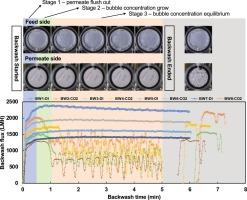陶瓷微滤膜的过饱和二氧化碳增强反冲洗
IF 9
1区 工程技术
Q1 ENGINEERING, CHEMICAL
引用次数: 0
摘要
以过饱和co2增强反冲洗(SCEB)作为纯水反冲洗的替代方法,对陶瓷微滤膜的除污效果进行了试验。常用气泡对微滤膜和超滤膜进料侧表面进行切向冲刷,以增加精练和松饼层;这被称为空气辅助反冲洗。与空气辅助反冲洗不同,SCEB迫使溶解的二氧化碳和二氧化碳气泡通过膜孔。在本研究中,直接分析了SCEB过程中的跨膜压力(TMP)和通量分布,以揭示准确的成核位置。恒通量过滤结果表明,与去离子水反冲洗相比,SCEB回收了更多的过滤TMP,在过滤湖水、过滤活性污泥和过滤废水时分别节省了6.5%、2.7%和6.9%的能量。首次实现了膜渗透的可视化,证实CO2气泡在进入膜基质之前没有形成。直接监测了SCEB本身的压力和通量分布。分析了恒流量反冲洗的压力分布,进一步了解了清洗机理。恒流量SCEB的结果显示,与去离子水反冲洗相比,CO2气泡的负压更大,这意味着在SCEB过程中CO2气泡穿过膜孔并产生更大的阻力。可视化证实,CO2气泡在膜孔内成核,而不是在滤液侧,以清除膜基质深处堵塞的污染物。在SCEB过程中,CO2气泡的行为可分为3个阶段:1)渗透液冲出,2)气泡浓度增长,3)气泡浓度平衡。最后一阶段CO2气泡浓度最高,作为孔隙洗涤实体,由于成核速率高、附加剪切应力大、举升力大,对提高清洗效果起着重要作用。本文章由计算机程序翻译,如有差异,请以英文原文为准。


Supersaturated carbon-dioxide-enhanced backwash of ceramic microfiltration membranes
Supersaturated CO2-enhanced backwash (SCEB) was tested as an alternative to clean-water backwash to enhance the effectiveness of foulant removal for ceramic microfiltration membranes. Air bubbles are commonly used to tangentially scour the feed side surface of micro- and ultrafiltration membranes to add scouring and loosen cake layers; this is called air-assisted backwash. Unlike air-assisted backwash, SCEB forces dissolved CO2 and CO2 bubbles through membrane pores. In this study, transmembrane pressure (TMP) and flux profiles during SCEB were directly analyzed to reveal the exact nucleation location. The results from constant-flux filtration show that SCEB recovered more filtration TMP compared to DI water backwash, which saves 6.5%, 2.7%, and 6.9% of the energy during lake water, activated sludge, and rendering wastewater filtration, respectively. Visualization of the membrane permeate is done for the first time, confirming that CO2 bubbles were not formed before entering the membrane matrix. The pressure and flux profiles of SCEB itself were directly monitored. The pressure profile from constant-flux backwash was analyzed to further understand the cleaning mechanism. The results from constant-flux SCEB showed more negative pressure than DI water backwash, which means that CO2 bubbles went through the membrane pores and created more resistance during SCEB. The visualization confirms that CO2 bubbles nucleated inside the membrane pores rather than on the permeate side to clear the foulant blocked deep inside the membrane matrix. The behavior of CO2 bubbles can be divided into three stages during SCEB: i) Permeate flush out, ii) Bubble concentration growth, and iii) Bubble concentration equilibrium. The last stage has the highest concentration of CO2 bubbles, which work as pore-scrubbing entities and play an important role in better cleaning effectiveness because of the higher nucleation rate, extra shear stress, and greater lifting force.
求助全文
通过发布文献求助,成功后即可免费获取论文全文。
去求助
来源期刊

Separation and Purification Technology
工程技术-工程:化工
CiteScore
14.00
自引率
12.80%
发文量
2347
审稿时长
43 days
期刊介绍:
Separation and Purification Technology is a premier journal committed to sharing innovative methods for separation and purification in chemical and environmental engineering, encompassing both homogeneous solutions and heterogeneous mixtures. Our scope includes the separation and/or purification of liquids, vapors, and gases, as well as carbon capture and separation techniques. However, it's important to note that methods solely intended for analytical purposes are not within the scope of the journal. Additionally, disciplines such as soil science, polymer science, and metallurgy fall outside the purview of Separation and Purification Technology. Join us in advancing the field of separation and purification methods for sustainable solutions in chemical and environmental engineering.
 求助内容:
求助内容: 应助结果提醒方式:
应助结果提醒方式:


